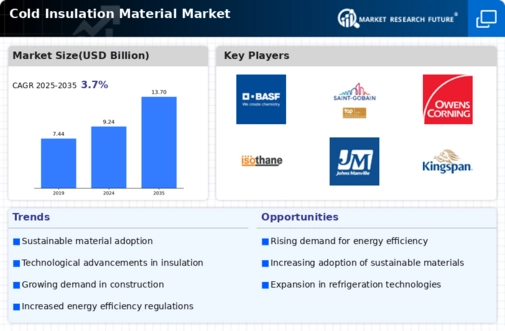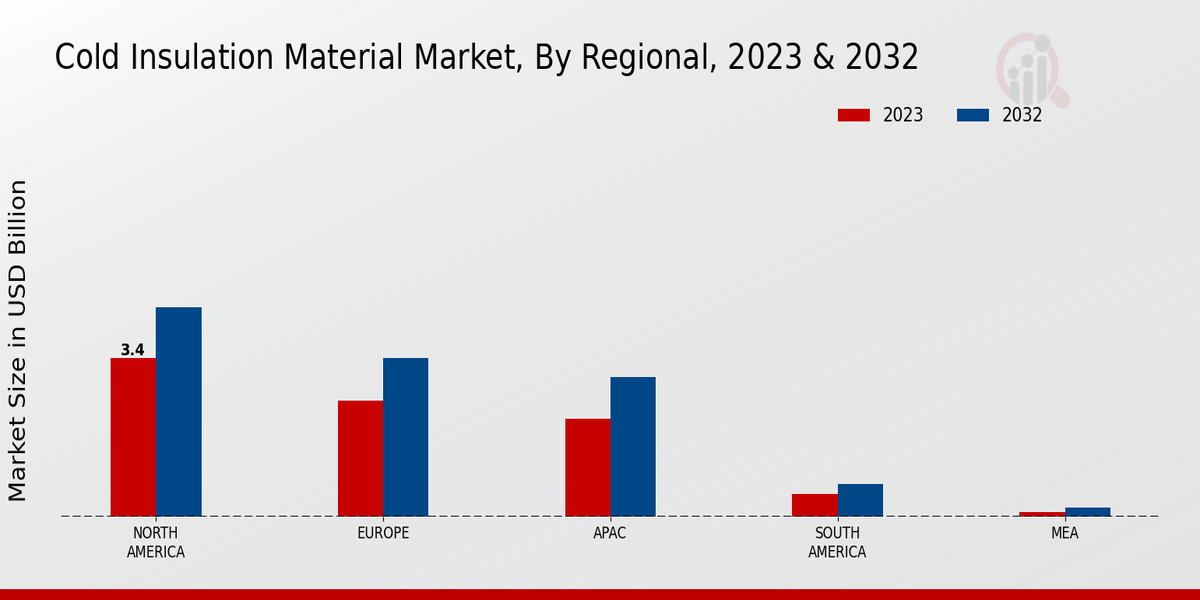Market Trends and Projections
The Global Cold Insulation Material Market Industry is characterized by several key trends and projections. The market is expected to grow from 9.24 USD Billion in 2024 to 13.7 USD Billion by 2035, reflecting a robust CAGR of 3.66% from 2025 to 2035. This growth trajectory indicates a sustained demand for cold insulation materials across various applications, including refrigeration, HVAC, and industrial processes. Factors such as technological advancements, regulatory support, and increasing awareness of energy efficiency are likely to shape the market dynamics in the coming years. The interplay of these elements will be crucial in determining the future landscape of the cold insulation materials market.
Growing Demand for Energy Efficiency
The Global Cold Insulation Material Market Industry is experiencing a surge in demand driven by the increasing emphasis on energy efficiency across various sectors. Industries such as refrigeration, HVAC, and petrochemicals are adopting cold insulation materials to minimize energy losses and enhance operational efficiency. The global market is projected to reach 9.24 USD Billion in 2024, reflecting a growing awareness of sustainability and energy conservation. As regulations tighten around energy consumption, companies are likely to invest more in advanced insulation solutions, thereby propelling market growth. This trend is expected to continue, with a projected CAGR of 3.66% from 2025 to 2035.
Rising Industrialization and Urbanization
The Global Cold Insulation Material Market Industry is poised for growth due to the rapid industrialization and urbanization occurring in emerging economies. As cities expand and industries proliferate, the demand for efficient refrigeration and HVAC systems is increasing. This trend is particularly evident in regions such as Asia-Pacific, where urban centers are experiencing significant population growth. Consequently, the need for effective cold insulation solutions is becoming more pronounced to ensure energy efficiency and reliability in these systems. This burgeoning demand is anticipated to contribute to the market's expansion, with projections indicating a market size of 13.7 USD Billion by 2035.
Regulatory Support for Environmental Standards
The Global Cold Insulation Material Market Industry benefits from increasing regulatory support aimed at promoting environmental sustainability. Governments worldwide are implementing stricter regulations regarding greenhouse gas emissions and energy efficiency, which encourages industries to adopt better insulation practices. For instance, initiatives aimed at reducing carbon footprints in the construction and manufacturing sectors are likely to drive demand for cold insulation materials. Compliance with these regulations not only enhances operational efficiency but also positions companies favorably in a competitive market. As these regulatory frameworks evolve, they are expected to further stimulate growth in the cold insulation materials sector.
Increased Focus on Food Safety and Preservation
The Global Cold Insulation Material Market Industry is significantly influenced by the heightened focus on food safety and preservation. As the global population continues to grow, the demand for efficient cold chain logistics is rising. Cold insulation materials play a critical role in maintaining the required temperatures during transportation and storage of perishable goods. This is particularly relevant in the food and pharmaceutical sectors, where temperature control is essential to prevent spoilage and ensure product integrity. The increasing awareness of food safety standards is likely to drive investments in cold insulation technologies, thereby fostering market growth.
Technological Advancements in Insulation Materials
Technological innovations are significantly influencing the Global Cold Insulation Material Market Industry. The development of advanced materials, such as vacuum insulation panels and aerogels, is enhancing thermal performance while reducing weight and space requirements. These innovations allow for more efficient designs in refrigeration and cryogenic applications. As industries seek to optimize their processes, the adoption of these cutting-edge materials is likely to increase. Furthermore, the integration of smart technologies into insulation systems may provide real-time monitoring and control, further driving market growth. This technological evolution is expected to play a crucial role in shaping the future landscape of cold insulation materials.






















Leave a Comment